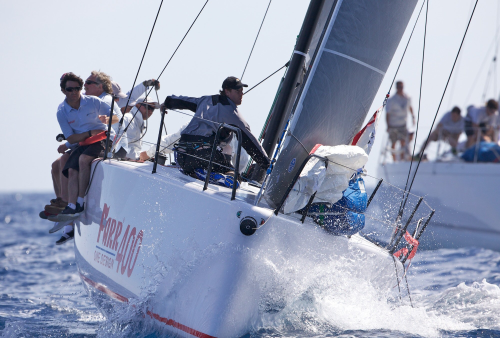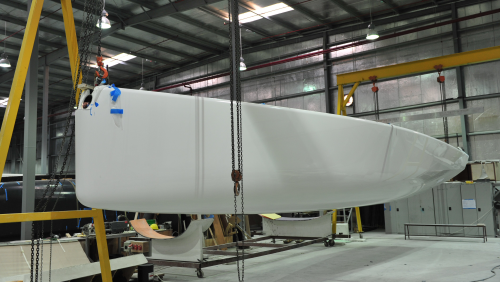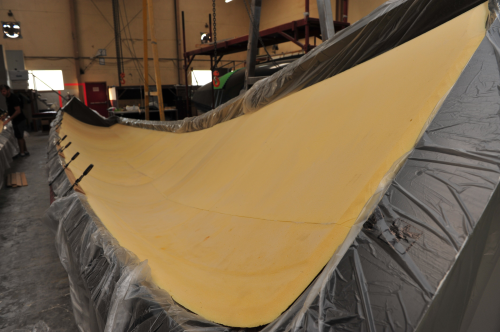


With Grand Prix capabilities and innovative design details, the Farr 400 has attracted considerable attention and was crowned Sailing World’s Boat of the Year 2012 in the Best Offshore One-Design Category and won Sail Magazine’s 2012 Best Performance 30 ft and Over Award.
The objectives for the Farr 400 were:
- to create a 40 ft racing yacht that delivers Grand Prix style racing synonymous with the larger, high performance TP52 class;
- to design a vessel that only requires a crew of nine;
- to ensure the yacht can be easily shipped around the world on a 40 ft flat rack container, thus providing huge cost savings for the owner.
For these reasons weight and performance were critical.
The construction process
To achieve Farr’s objectives, FORMAX recommended the highest quality carbon materials for the build. FORMAX is able to offer a range of fibre types, from 12K to large filament count fibres, whilst keeping costs down yet still maintaining excellent fabric quality through the use of the latest cut and lay machines.
“We worked closely with FORMAX and were able to select input fibres that were suited to the fabrics while maintaining a flexible supply chain with short lead times, which is always important for marine projects,” explains Max Waimer, PCT’s Technical Director.
The production of the Farr 400 began by CNC machining a master plug from tooling paste. This was then halved and both hull plugs were used to infuse the production moulds with FORMAX’s 1000 g/m2 hybrid glass and carbon fibre quadraxial fabrics.
Both the hull and deck laminates use a sandwich construction with carbon fibre/epoxy skins and foam core. FORMAX supplied the carbon fibre reinforcements using both 12K and larger filament count fibres.
FORMAX’s carbon biaxial fabrics 300 g/m2 and 400 g/m2 ±45° were applied to the main hull, deck laminates and the internal structure. An unbalanced, stitched 0°/90° fabric facilitates transverse stiffness in the hull and longitudinal stiffness in selected areas of the deck. The unbalanced construction of the fabric – 300 g/m2 warp and 200 g/m2 weft – allowed the use of a single ply in these areas. A 300 g/m2 woven unidirectional fabric adds reinforcement where finite element analysis (FEA) identified high loads, such as chain plates.
| We’ve made hundreds of moulds using wet lay-up, but we chose to infuse all of the moulds for this project because we wanted to pursue a very high-end production from the beginning. |
| Max Waimer, Technical Director, PCT |
The fabric’s construction is optimised for infusion using a 68 tex glass weft to improve resin flow and permeability. This saves time and money yet helps to guarantee a fully infused laminate which can be problematic when using multiple plies of carbon fibre unidirectional tapes.
“We’ve made hundreds of moulds using wet lay-up,” says Waimer, “but we chose to infuse all of the moulds for this project because we wanted to pursue a very high-end production from the beginning.”
“We wanted to ensure fewer voids and better saturation in the moulds, so that the composite hulls and decks we made from these would be of the highest quality,” he adds.
Waimer notes this also helps to maintain dimensional stability of the final parts.
After the half hulls are infused and cured the production moulds are moved together. The two half hulls have been specifically designed to be joined. The foam core is placed to leave a 100-150 mm margin from the keel line at a 3:1 chamfer, enabling each half hull to form one side of a ‘V.’ The skin laminates also are staggered away from the centreline.
They join precisely, thanks to locator pins, and have a seal that compresses to form a vacuum-tight, complete hull mould. A specially designed joint laminate is made by impregnating FORMAX reinforcements with epoxy resin using an in-house prepreg machine.
All the spars, spreaders and shrouds are carbon and supplied from leading spar supplier Southern Spars. The carbon mast splits into two sections, allowing for easy, cost effective, transportation.
Cost savings
The decision to adopt an infusion production process is proving economically sound. The combination of FORMAX’s dry fabrics and Gurit’s Corecell foam has achieved a 25% saving in labour expenses and a 50% saving in material costs compared to prepreg lay-up.
To date, 13 yachts have been sold to customers around the world. Remarkably, all the Farr 400s currently built weigh within 5 kg (11 lb) of each other, and those same boats, outfitted with rigging and numerous other composite and metallic components vary by only 35 kg (77 lb).
FCIM151 and FCIM105: 300 g and 400 g ±45 carbon biaxials are used in the main laminates of the hull, deck and internal structure. FCIM156: a 510 g stitched carbon un-balanced zero-ninety. This unbalanced cloth (300 g/m2 warp and 200 g/m2 weft) provides extra transverse stiffness in the hull and longitudinal stiffness in the deck with a single fabric ply. FCIM313: a 300 g woven unidirectional fabric optimised for infusion by using a 68 tex glass weft. This construction accelerates the infusion process, saving time and reducing costs, but also helps guarantee a fully infused laminate which can often be a problem with thick stacks of unidirectional fabrics. This fabric is used to provide extra reinforcement in the hull, deck, internal frames and the chain plates. |
The boat continues to perform exceptionally well on the water and recently won the First Division Performing Class at Audi Hamilton Island Race Week. ♦
This article was published in the January/February 2013 issue of Reinforced Plastics magazine.
The digital edition of Reinforced Plastics is distributed free of charge to readers who meet our qualifying criteria. You can apply to receive your free copy by completing the registration form.






